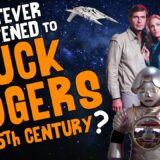
OBIR: Occasional Biased and Ignorant Reviews reflecting this reader’s opinion.

Pulp Science Fiction from the Rock
Published in 2020 by Engen books, St. John’s, Newfoundland, Canada.
Editors: Ellen Curtis and Erin Vance
Cover Art: Ariel Marsh
Introduction – by Kenneth Tam
Review: Tam states, “ … the editorial team identified some of the tropes that are typical in pulp: macho stereotypes, a damsel in distress, low-art. The goal of this collection is to subvert those stereotypes ….”
Delay en Route– by Peter Foote
Premise:
Two robots, running errands for their human masters, are waiting for the hover bus to arrive at a roadside bus stop.
Review:
This is a very short vignette, and quite traditional, because it “feels” old-fashioned. For one thing, it reflects the early tradition of robots being mere mechanical versions of human servants. I have often felt that this robo-stereotype was based on the racist concept of “good darkies,” i.e. dutiful black servants proud to serve their masters, a type of character found in many a non-genre movie, book and story back in the day. In other words, robots in pulp SF seem futuristic, but in fact reflect prevailing social mores in a manner that most readers in the pulp era would find thoroughly comfortable and acceptable.
The subversive element is that one can’t help but feel sorry for the robots. They’re pretty good at what they do, but are severely handicapped by the limitations of their programming. That robots represent dehumanised people serving demeaning roles is fairly common in SF literature. Here I believe Peter is focusing on the idea that the suffering of individuals isn’t their fault, but rather the result of their “programming,” the demands and expectations imposed by their employers. So, is the lot of a robot a happy one? It thinks so, but then it’s been programmed to think that way. A happy robot is a pathetic robot, unable to cope with circumstances beyond the limit of its programming. I think Peter is saying, yes, robots represent humans, but, more importantly, humans are really robots and will continue to be such as long as we treat “lesser folk” as menials to be manipulated. We need to do a better job of programming people, never mind robots. At, least, that’s how I interpret the story. Lots to think about.
Heroics 101 – by Ali House
Premise:
Rick Brawnly is a former space hero who teaches a first year class in heroics at the Space Academy. His 14 students look the proper sort, keen, muscular young men capable of impressing more damsels than just the ones in distress. Wait a minute … there are 15 names on his list. Someone missing?
Review:
While a lot of fun, this is more than a modern spoof of an old genre, there are still plenty of men who think like Rick Brawnly, some of them influential and powerful in the world today. His reaction is their reaction to the concept of genuine equality of the sexes. Simply put, many men do not believe women are as capable of men, except for the occasional freak, who is probably a Lesbo anyway. Cliché stereotypes tend to be based on false but nevertheless sincerely believed assumptions. This may appear an obvious and annoying piece of mansplaining on my part, but my point is that there remain many men (and women) who would regard the positive message conveyed in this story as the wildest science fiction possible and frighteningly subversive of the natural order of things. In other words, this story is not just an amusing spoof of the way things used to be, but also a wake-up call to the way things are now, a message still relevant and necessary. Especially in light of the increasing possibility of social progress being legislated backwards. Some of the women I’ve known all my adult life have recently expressed frustration that they keep running into young women who know nothing about the history of “the struggle” and worse, don’t believe there exists anything to struggle against. If they recognise feminism at all, they assume there’s no longer any need for it. These modern girls are wrong. Silly and fun and light-hearted as this story appears to be, the message buried in its core remains vitally important.
Namaily – by Matthew Daniels
Premise:
Human survey teams on a newly discovered planet are annoyed to discover their company saved money by skimping on the previous, entirely automated survey. Thus the silicon-based life forms come as a considerable surprise.
Review:
Unusually, the story is narrated from the point of view of a pet cat, a sort of mascot aboard a rover crewed by a single man. Presumably the cat is there to provide emotional support, though both appear equally aloof. The cat is as aware of the growing problems presented by the local life forms as any of the humans aboard their many roving research vehicles, but doesn’t particularly care.
The fun of the story lies in the humans’ increasing desperate attempts to stay alive. Seems like a typical concept-driven short story, vaguely reminiscent of Harry Harrison’s Death World trilogy. This can be said of almost every piece of fiction dealing with hostile, alien ecologies. It’s the sort of thing I quite enjoy. So what’s the subversive element? The cat. Could be that we, as a species, are no-where near the “cat’s meow” we’ve always assumed. (To use an archaic expression—something I do a lot, you may have noticed.)
The Pale Horse – by Brad Dunne
Premise:
Cheryl MCleod, like the other colonists on Planet Telex, cannot understand why a planet with a breathable atmosphere, suitable temperature variations, plenty of water, and lots of organic minerals, is so incredibly resistant to Terraforming. Not only is the environment weirdly incapable of sustaining humans, it appears never to have evolved native life of its own. How is this possible?
Review:
Again, the sort of concept-driven SF I find quite intriguing. I would guess the subversive element is the concept that we humans are blinkered by our tendency to operate off assumptions dependent on obvious deductions drawn from our previous experience. Consequently, we might not be capable of coping with galactic exploration after all. Or, to put it another way, it won’t be as easy as we would prefer to think. Just as exploration ships in the age of sail set out with far larger crews than were necessary to operate the ship safely back to port, space exploration vessels will need plenty of red-shirt crew on hand. Expedition-planning bean counters take note.
The Photograph – by Melissa Bishop
Premise:
Mary Anne is pleased with her life and her husband Charlie. Mind you, she never much liked the series of science fiction novels he was famous for. Far too bleak to be entertaining, in her opinion. And the photograph of a desert with two dead trees he kept above his desk she found quite depressing. Otherwise life was perfect.
Review:
This is a classic SF tale. Not quite sure what the subversive element is. Possibly a reminder that things aren’t always what they seem. One thing about Mary, she’s not one for letting a little depression get her down. Can’t say more without giving away too much.
Green – by RC.S. Woodburn
Premise:
As humanity explores, humanity mutates, sometimes deliberately. Spacefarers, masters of medical augmentation, visit colony after colony, curing the negative effects of planned mutation and acquiring samples of newly evolved organs and DNA. Their motivation is not altruism, but profit.
Review:
This has the feel of hard science, but really it is speculative extrapolation of what current medical experimentation will ultimately produce. The subversive aspect? A prominent science pundit (can’t remember who) once commented that advanced medical science will never benefit mankind as a whole, because it will be reserved for the super rich. Yes, scientific wonders are possible, but will be exploited by the rich and ruthless. Nor will it be a matter of individual greed. Such power tends to become institutionalized and form the very basis of economics and social structure. Could well be inevitable. Turns the whole Gernsbackian idea of scientific utopia on its head. Compared to the future described in this story, we, today, live in the best of times. Now, that is subversive!
Ceres – by Alissa Hickox
Premise:
Frank Moshan singlehandedly operates a refueling station on the asteroid Ceres, servicing everything from rust-bucket tramp freighters to high status space liners. He does his job well and is tipped accordingly. Unexpectedly, he receives a visitor, a beautiful woman scientist who wants to check out the salt pools. This is most unusual, and a tad suspicious.
Review:
Definite throwback to the pulp era. Melodrama with fisticuffs aplenty (the time honoured way to solve problems in pulp fiction) and quasi-villainous aliens who can’t be bothered to understand humans. I confess I’m not quite sure what the subversive element is. That empathy is a more useful weapon than a well-thrown fist? That even the worst villain has a streak of sentimentality that can be exploited? Commiseration a better tactic than confrontation? In short, greater emotional complexity to be found than your usual pulp fiction tale of yore. All in all, considering this is Alissa’s first published story, it is quite good, and certainly a lot of fun to read.
The Cat’s Meow – by Shannon K. Green
Premise:
Two young stowaways, brother and sister, are discovered aboard a ship bound for the brand new Alpha Centauri colony. Though not educated, they possess survival skills and are willing to work hard. Consequently they are treated as supplemental crew earning their passage. Most importantly, they are well fed. They are, for the first time in their lives, content. Then disaster strikes.
Review:
Stowing away aboard a spaceship is a hoary tradition in science fiction. Think of the young lad who hides aboard the spaceship in the 1929 German film Woman in the Moon. So, something new and original has to be added to the tradition to make it worth reading. This story vaguely reminds me of a classic early SF story but just barely. I wouldn’t say this is a variation of that tale so much as an additional take on a major theme, albeit one merely hinted at in a bit of dialogue between the siblings. This puts me in the unusual position of saying the story works but only if the reader makes certain assumptions based on a small number of clues. Oddly, if the brief bit of dialogue, which raises certain questions, were to be removed, the story would work just fine. Yet the dialogue is essential to the science fiction nature of the story. It is the original touch (in its implications) that subversively defies tradition. Without it the story could take place onboard any modern tramp steamer, or a 19th century Clipper ship.
I know the above doesn’t make any sense, but I dare not explain because that would give away the ending, which took me took me by surprise. Maybe it shouldn’t have, but I got suckered in by the comfortably pulpish situation and setting and was anticipating something a bit more … well, traditional. Full marks to Shannon for leading me astray.
First Visit – by Andrew McDonald
Premise:
A meteor landed on the outskirts of town. People began acting strangely. Somebody blew up the local factory. The police are puzzled. So the army sends in tough old Howard and his newly-minted sidekick Elliot to check out the night watchman from the factory.
Review:
Howard is a man of iron. Or perhaps steel. Can’t soft-talk him out of anything. He’s seen it all. He used to hunt Nazi war criminals. The current case should be a walk in the park. Suspect give him any lip, suspect is a dead man. Too bad Elliot is willing to give people the benefit of a doubt.
In other words, we’re deep within the pulp territory of the hard-nosed, cynical, and quite ruthless crime investigator who routinely solves the case with the use of his gat. (This is a short form of “gatling gun,” a 19th century weapon which, in the depression era, became a slang expression for the Thompson sub-machine gun or Tommy gun.) Normally a gat concludes many an argument most efficiently. The ability to be more violent than the criminal (or enemy) was always a symptom of triumphant justice in the pulps. But what do you do when the old tried and true no longer guarantees success? Subversive question, that.
This is Andrew’s first published short story. As a satire of hard-boiled “cop fiction” it works. A few rough edges, but that adds to the authenticity, to the “pulpish” tone. May strike some as over-the-top, but I found its exaggerated action a source of subtle humour. To put it another way, genuine pulp fiction tended to skirt the edges of self-parody. I think Andrew plays on this quite successfully.
Slipdream – by Andrew Pike
Premise:
The year is 1893. The place is Mars. A young hero struggles valiantly to save a beautiful alien woman from the evil villain’s evil robot.
Review:
Slipdream, I assume, implies a form of fiction even more surreal and anti-realist than slipstream literature. Certainly the technology and situation in the above story is not at all credible, nor is it meant to be. It’s just good, pulpish fun albeit with an unexpected twist ending that “betrays” the normal expectations aroused by traditional pulp.
Thing is it turns out to be a dream, and merely the beginning of the actual story, which has to do with humanity embracing nanobot technology, a bad move which threatens to render the human race extinct. The real hero is a young woman named Ashlyn, a cognitizer aboard a spaceship traveling through time, whose job is to enter the dreams of historically influential people and convince them that technology is more threat than salvation. It is hoped that eventually this subtle sabotage of the chain of events will alter the course of history and save humanity. This may well succeed, since the mentality of the nanobots is incapable of penetrating the dreamworld of organic beings. Trouble is Ashlyn is getting bored with the task and beginning to question her dedication.
Though the use of technology to enter the dream state or the subconscious as a whole is a major theme in many a book and film, this strikes me as an original variation of the usual. Often such stories concentrate on the personal consequences of experiments existing in a social vacuum, as in many a pulp tale where a mad scientist invents a wonderful machine, only to see the plot devolve into the hero’s fisticuff efforts to rescue the kidnapped daughter; the implications of the machine itself being ignored. In this story the high technology, the dream manipulation, and the ultimate fate of humanity are all of a piece, seamlessly woven together in a satisfying race against time. The story subverts pulp fiction in the sense that it presents a mature version of same, a more evolved version. Of course, it only works if you accept the premise, take the dream intrusion technology for granted, but hey, that’s what readers are supposed to do. Slipstream fiction works when the reader grants validity to the surreal. The result, as in this story, is quite a treat.
The Mouse – by Lisa Daly
Premise:
Two space workers walk into a bar. They’re in the mood to celebrate. Little do they know the tough-looking bruiser sitting in the corner is an infamous criminal.
Review:
Ordinarily, a bar full of rough customers promises violence, at least in pulp tradition. Heck, it even happens in movies as innocuous as Abbot and Costello Meet the Mummy. In this story the bar is a mere framework for the revelation of self-serving shenanigans pulled by both dishonest and honest citizens, courtesy of the improbable technology of the future. Its not really a story in itself, so much as an excuse to tell two independent tales. What connects the two is the common theme of clever individuals flouting the rules to their own advantage in spite of the punishment they face should they be caught. The lesson being, I suspect, that human nature will remain the same no matter how technology and society evolves. The subversive element is the confounding of expectations raised by the introduction of the setting. A pleasant interlude in the midst of hardcore pulp exaggerations like First Visit and For the Crown. Again, turning pulp fiction upside down. So, a successful act of subversion as required by the editors.
For the Crown – by Steve Power
Premise:
The year is 1865. British solders are about to charge across an open Venusian landscape to crush the last of the Prussians defending the Kaiser’s evil ambition to rule the solar system from Mercury to Pluto.
Review:
Steampunkish pulp, you could say. Definitely alternate history. The Europeans have spacecraft, but fight with sabres and guns firing everything from magnesium bullets to chunks of iron. The stupid battlefield tactics that built the British empire at the expense of myriad young men are still in place. Venus (referred to throughout as “Ishtar,” a variant of the goddess) is a tad more liveable than our version, though not by much. Handicapping any thoughts of escape, the looming presence of the dense Venusian jungle, from which no explorer has ever returned. All this is very cool. Love it.
The subversive element? I’ll just say a strong hint of why the British Empire ultimately collapsed. It turns out, in the long-term historical scheme of things, that victory or defeat ultimately doesn’t matter. One of the reasons the “death or glory” mentality is so obscene, albeit often necessary in the short-term. Good thing our life-span is so limited. Otherwise we might wind up very depressed.
Note: ten stories still to go but I have a deadline to catch. I have no doubt they are all as nifty as the ones I reviewed.
CONCLUSION:
This is a highly entertaining anthology. The editors asked for stories faithful to pulp fiction but with modern twists that subvert, or perhaps I should say “transcend” its limitations. The writers delivered. For them as likes old-fashioned SF it is a wonderful bunch of stories. And for them as wants to avoid the same-old, same-old, there is an abundance of original touches. Best of both worlds if you ask me. I had gleeful good fun reading this. Maybe my tastes are bizarre to the point of being uniquely unique, but I doubt it. Strongly suspect many people are going to love this anthology as much as I do, which is my subtle way of saying I recommend this book!
P.S. “The Rock” of the title is, of course, slang for Newfoundland.
Check it out at: < Pulp Science Fiction >










